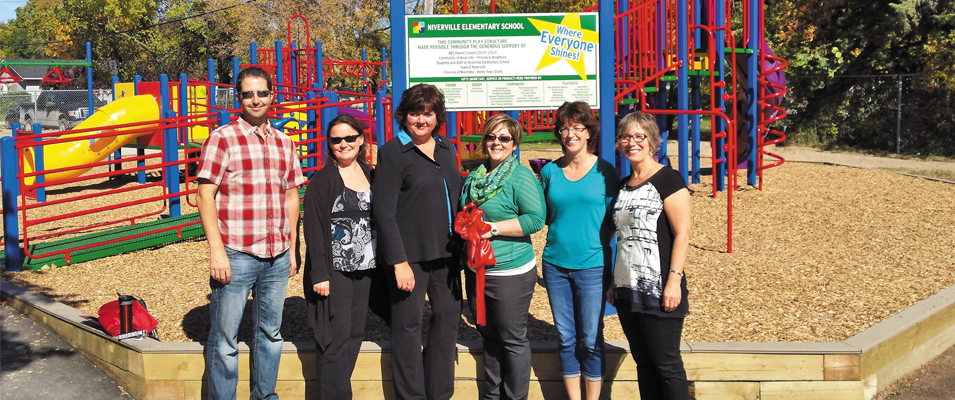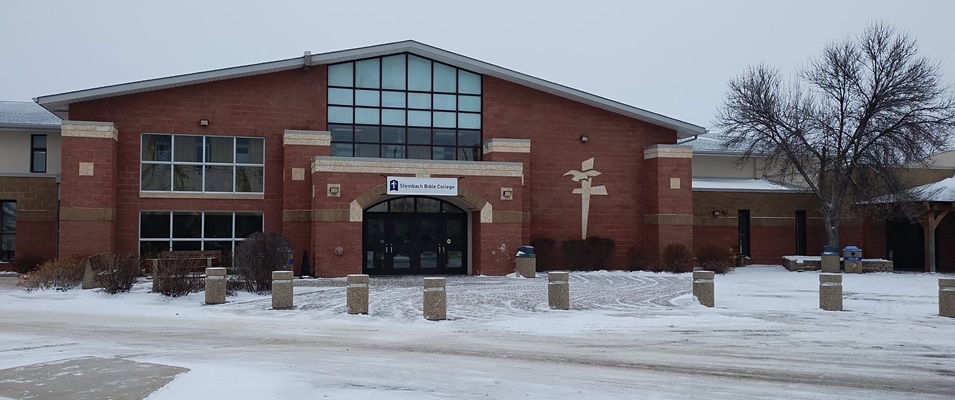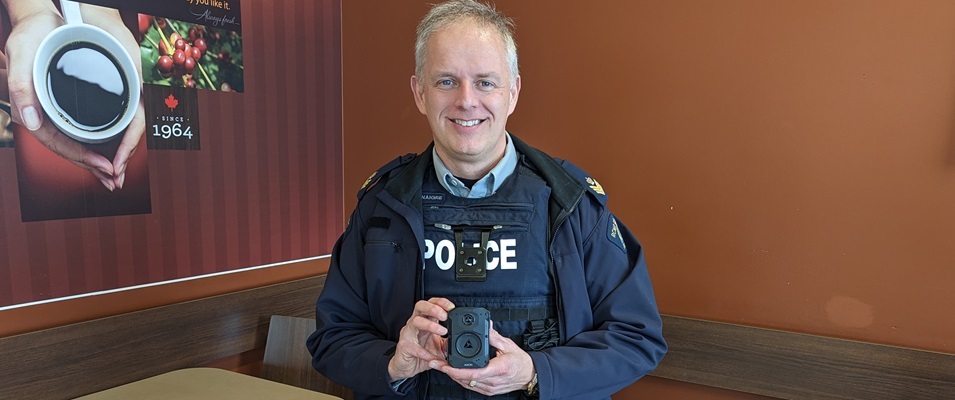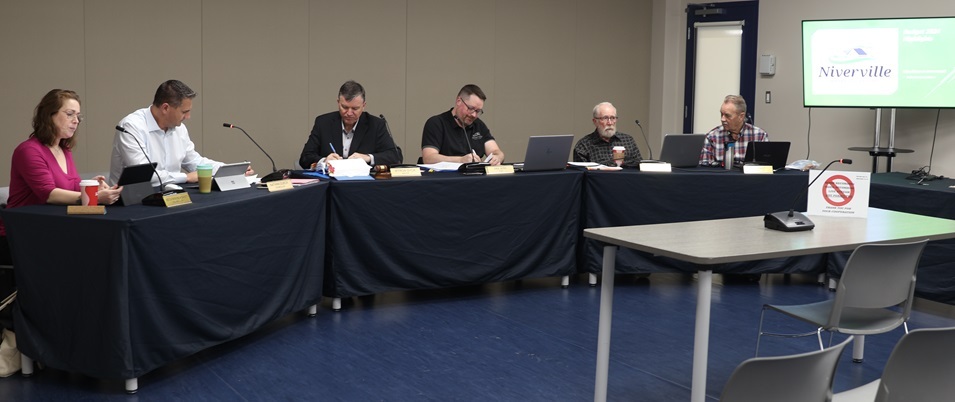
It is said that the conundrum of the middle child is that they are easily overlooked. They are not the oldest, breaking new ground and receiving firstborn privilege. They are not the youngest, whose baby-of-the-family status induces extra attention from doting parents. The middle child is stuck somewhere in between, easily forgotten and perpetually in hand-me-downs.
A collection of parents with children in Niverville Collegiate Institute (NCI) feel the same is true for their middle-years students. They are stuck in a system that revolves around the needs of high schoolers, trapped on a playground of hand-me-down structures and about to inherit a school building that was designed with older students in mind.
“There is [virtually] nothing outside, in terms of space and equipment, for children to play with at recess,” says Leslie Bardal, parent of two NCI students. “My son and his friends have shared that they are bored at recess and outdoor gym time and they miss how much was provided for them at Niverville Elementary School.”
Another parent whose child will be transitioning to NCI this fall agrees. Due to a request for anonymity, we will call them Parent X.
“My concern is that the play activities that are already there have always been there and weren’t put in place with Grades Five to Eight [in mind],” says Parent X. “It really isn’t the right setup for these kids. When I ask my child how they feel about going over to Grade Five, they say they would love to see monkey bars and things to climb. When we cycle or walk past the school, they think it looks very boring.”
In 2011, plans were implemented to begin moving the Grades Five and Six students from the overcrowded elementary school into portable huts installed at NCI. Until that time, NCI had catered to Grades Seven through 12. The high school underwent a few nominal changes outside of huts to accommodate the younger students. The outdoor recreation area saw the inclusion of a new swing set with eight swings.
The relocated children missed their opportunity at a brand-new play structure at NES introduced to the school’s playground just a few years later. The structure, a labour of love created through years of Parent Advisory Council (PAC) fundraising efforts and community participation, cost about $70,000. It had been designed with all ages of children in mind and included unique accessibility features for children with special needs.
Leslie Bardal and Tanya Pomaranski were both members of the NES PAC during those years and recall vividly the amount of time, effort, and commitment it required to see this play structure project through to completion. It was a proud day when community volunteers, teachers, and the principal arrived to help erect it. They were prouder still to see a young handicapped student be the first child to use it, rolling in his wheelchair onto the structure’s accessibility ramps.
The idea to incorporate these mobility-friendly features came from the students themselves. The NES PAC of the time made it a point to involve children in the planning. This gave the children opportunities to express their desires and feel included in the process, giving them a heightened level of excitement as the project unfolded. Several students had raised concerns in the early stages that their handicapped friend may not be able to use the structure along with them.
Since that time, this young special-needs student has moved on to NCI. His mother, Lyndsay Eidse, is disappointed with her son’s inability to enjoy recesses at the new school.
“Special-needs kids need interaction with other peers,” says Eidse. “It’s so important for them, and also for [mentally or behaviourally challenged] kids, to learn how to interact and communicate with each other. [It builds] social development and prepares them for life as an adult. If these kids don’t get the social interaction with kids during recess, when will it happen? They don’t typically get invited to friends’ houses to play. Right now, there are a few swings which are surrounded by pea gravel and there isn’t one for wheelchairs.”
Eidse says that she’d like to see a child-focused approach to the discussion about outdoor play enhancements, similar to NES’s approach.
“We, as parents, could all say what we would like to see for our kids, but why don’t we take a student-led approach and let our kids know that their voices matter?” says Eidse. “Have a discussion with your kids in the NCI and ask them what would they like to do at recess?”
The Future of Recess
The lack of playground enhancements is only one of the concerns these parents share.
Bardal says that the middle-years students have been exposed to a drastic and sudden decline in play and recreation. She adds that, in conversation with Principal Michael Koester, she’s been informed that the NCI administration is entertaining the possibility of eliminating the middle-school recess periods altogether and replacing them with five-minute breaks between classes, similar to a high school model. Koester further indicated to her that the lack of administrative supervision for outdoor recess is a key factory in that decision.
Due to The Citizen’s inability to contact Koester for confirmation, as per the Hanover School Division’s media policy and the time of year, no comments could be obtained. Helene Connelly, executive secretary to HSD’s superintendent, responded merely by stating that such a decision would be dependent on the school in question and that parents should speak directly to NCI’s principal regarding their concerns.
The elimination of recess in middle schools, and occasionally elementary schools, is not a new phenomenon. According to Nicholas Day, in an article for Slate entitled “The Rebirth of Recess,” many schools around the U.S. went recess-free years ago—but some are starting to reintroduce recess, recognizing the invaluable connection between well-developed children and playtime.
“Every minute of the school day has been scrutinized for its instructional value and recess—a break from instruction—often didn’t survive the scrutiny,” writes Day. “It was, by definition, a waste of time.”
He adds that a school administration’s arguments against recess usually centre on the belief that more classroom time and less unstructured playtime will result in better academic performance. But Day doesn’t agree.
“Repeated studies have shown that when recess is delayed, children pay less and less attention,” Day says. “They are more focused on days when they have recess.”
The American Academy of Pediatrics (AAP) has done extensive research on the topic and published an article in their medical journal, Pediatrics, to relay their findings.
“The AAP believes that recess is a crucial and necessary component of a child’s development and, as such, it should not be withheld for punitive or academic reasons,” says the AAP’s Council on School Health in their article entitled “The Crucial Role of Recess in School.” “Recess represents an essential, planned respite from rigorous cognitive tasks. It affords a time to rest, play, imagine, think, move, and socialize. After recess, for children or for adolescents, students are more attentive and better able to perform cognitively. In addition, recess helps young children to develop social skills that are otherwise not acquired in the more structured classroom environment.”
Parents Propose a Solution
Bardal and Pomaranski believe that airing parental concerns to NCI’s administration is important, but it’s not enough. Becoming active members of NCI’s PAC would have a far greater impact on the overall health and welfare of the middle-school children.
“Leslie and I have learned that middle-years representation and interest in fundraising are not a focus for the current PAC,” says Pomaranski. “They have operated as an advisory committee for many years—[which is] acceptable and understandable for a senior years’ environment—and are content to manage as such going forward.”
Both have expressed an interest in joining the current four-member PAC, but they say that changes to the structure would be required if they and other working parents were to come on board. At present, NCI’s PAC meets during lunch breaks, once per month in the principal’s office. Upon inquiry, both women received little indication that this meeting time and location is flexible.
Pomaranski, who previously served for six years as president on the NES PAC, says NCI’s PAC has outdated policies on their website and provides little information to parents by way of official public minutes of their meetings.
“Moving from a structured environment at NES to a very different environment at NCI is a difficult transition for Grade Five parents,” says Pomaranski. “Parents feel frustrated with communication formats, not knowing where to look to find information or understand what the PAC focus is. Or even how to reach out to them, find out when meetings are, or where to attend. Generally, I would say the group of [middle-years] parents feel ill-informed and unwelcome.”
Alison Fehr, chairperson of the existing PAC, says that the advisory council operates fairly.
“Meeting times are in no way set in stone,” says Fehr. “The current time of our meetings was based on the dynamic of the committed volunteers we had for the 2016/17 school year… [We are here] to work in cooperation with the parents, school staff, trustees, and members of the community to support and enhance the learning experience of the students of the NCI.”
The PAC’s duties, Fehr says, may include advising the principal regarding school policies, activities, and student behaviour management. Their goal is to establish ongoing communication with all parents of the students, and with community members.
Because Hanover School Division policies allow for only one PAC per school, Bardal and Pomaranski recognize that a second middle-years PAC is not an option nor conducive to a spirit of unity for the entire school. In two years, when the senior high students move to their new school, a separate PAC for middle years will be a necessity.
But the time to begin that representation, they say, is right now.
“Planning and conversation must start now for possible playground enhancements as the majority of money will need to come from grants, donations, and fundraising,” says Bardal, who was the chairperson of NES’s previous Play Structure Committee.
Both women strongly encourage a contingent of middle-years parents to join the NCI PAC and provide a stronger voice for middle-years needs.
“Programming, special events, and recess playtime are very different at ages 10 to 12 than at senior years,” adds Bardal. “An updated constitution that [offers better] parent advising and input, as well as fundraising for equipment, special events, and playground enhancements would be advantageous.”
“We have an opportunity to learn from one another now,” Pomaranski says. “With the support of the current administration and PAC, we could certainly be a fantastic, collaborative, and experienced group around the table to assess and meet the middle-years needs at NCI, now and in the future.”
Fehr says that she supports any middle-years parents who wish to become more proactive and join the advisory council. “We would love to have more members join. If there are enough committed parents that would appreciate a different meeting time, we can definitely discuss that at our fall organizational meeting. All interested parents are welcome to attend.”
Bardal and Pomaranski encourage middle-years parents to seek out and sign the PAC member list, which will be available at NCI on Meet the Teacher night in September. Fehr says that they will attempt to have a notice posted on the school’s website regarding the date and time of their first organizational meeting.




















